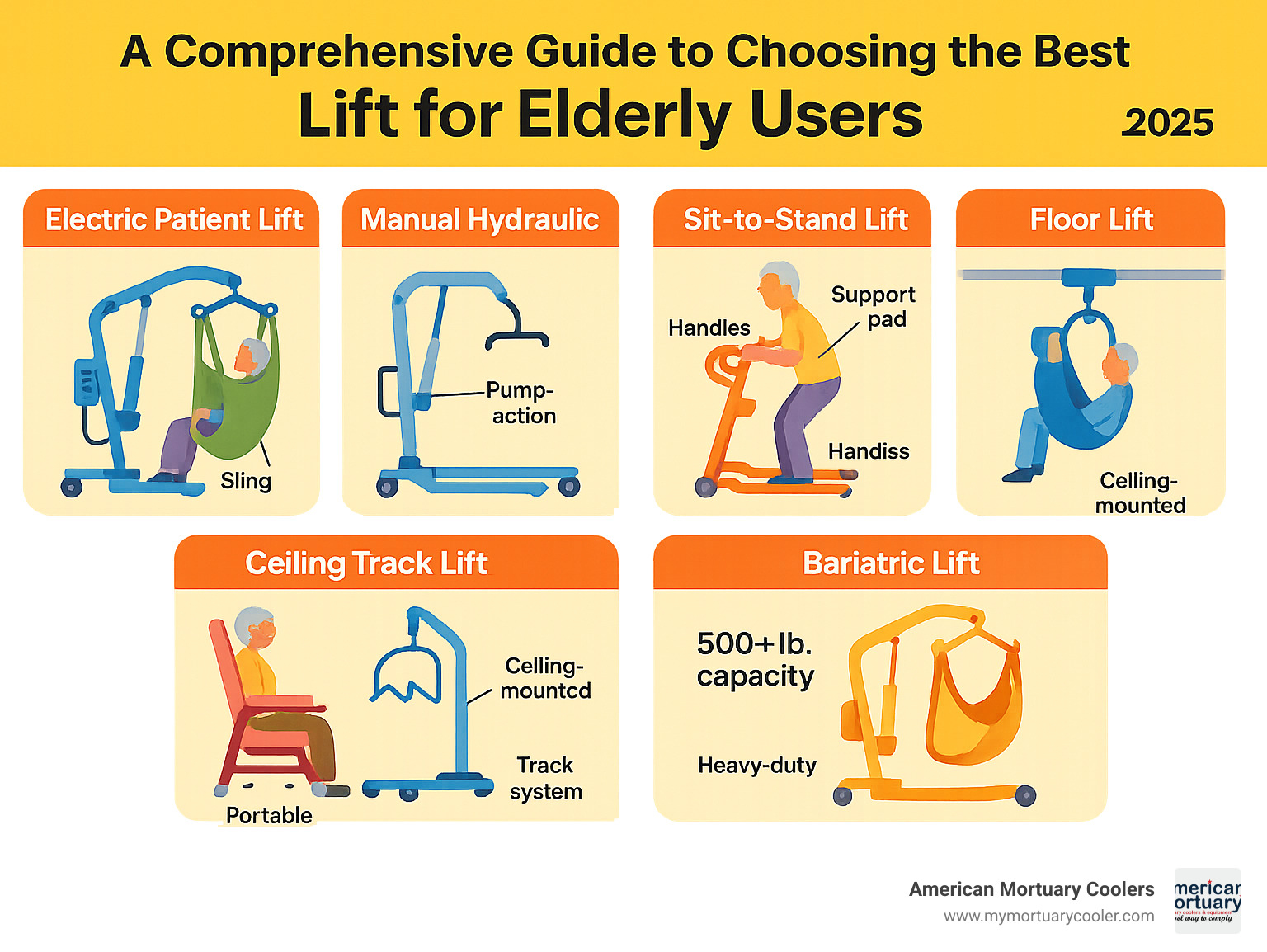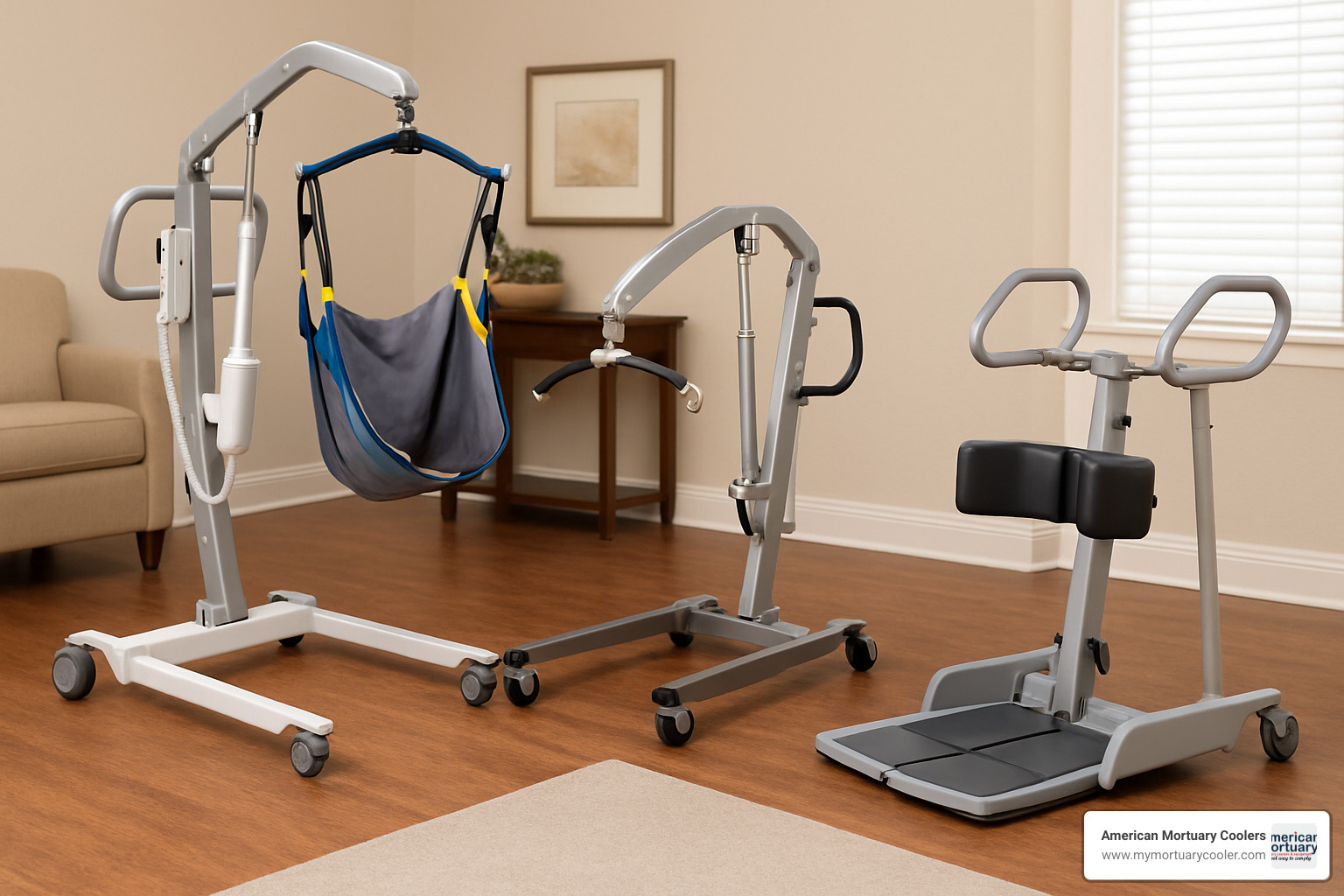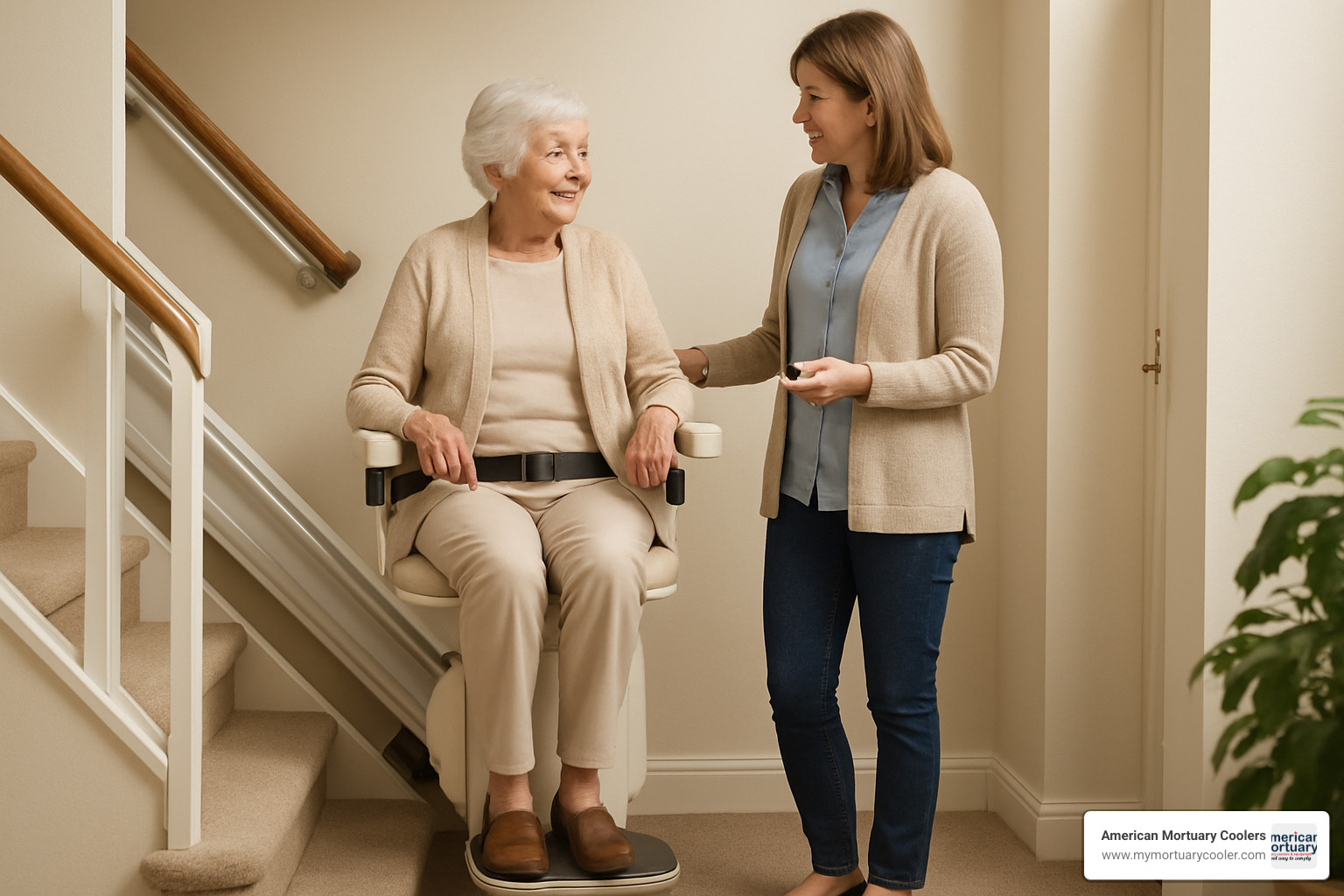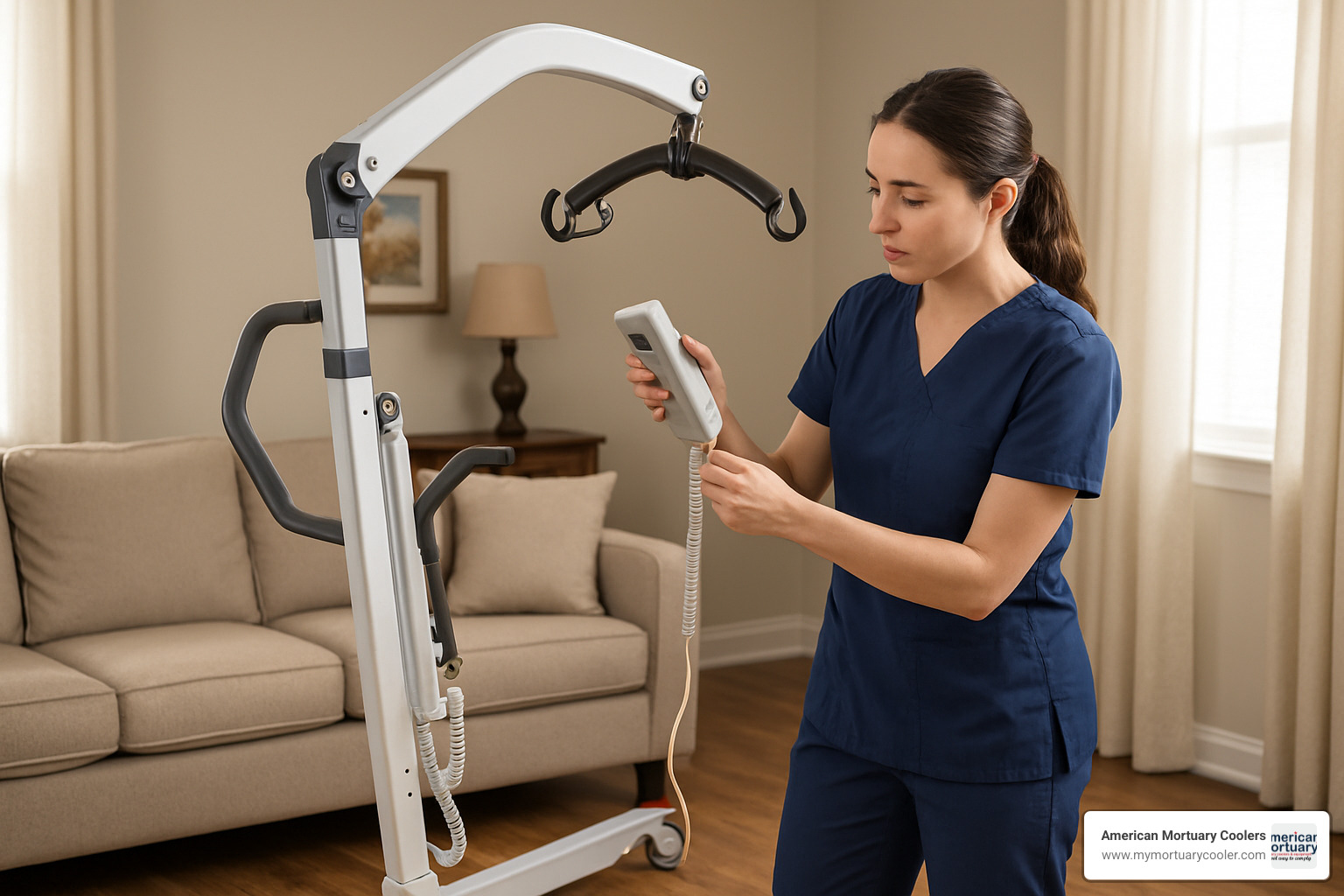Why Choosing the Right Lift for Elderly Users is Critical for Safety and Independence
A lift for elderly users is a mechanical device designed to safely transfer individuals with limited mobility from one position to another, such as from bed to wheelchair or chair to toilet. These essential mobility aids help preserve dignity while reducing the physical strain on caregivers.
Quick Answer - Main Types of Lifts for Elderly:
- Electric lifts - Battery-powered with handheld controls for smooth transfers
- Manual hydraulic lifts - Budget-friendly pump-action models requiring no electricity
- Sit-to-stand lifts - For users who can bear some weight and assist with standing
- Floor lifts - Portable chairs that help lift someone who has fallen
- Ceiling track lifts - Permanent installations for frequent transfers
- Bariatric lifts - Heavy-duty models supporting 500+ pounds
Over 700 electric patient lifts were purchased on Amazon in the past month alone, showing the growing demand for these devices. Research published in the Journal of Occupational and Environmental Medicine found that using mechanical patient lifts significantly decreased musculoskeletal symptoms and injuries among caregivers.
Falls account for 87% of all fractures among people over 65 and cause 40% of nursing home admissions. Whether you're caring for a loved one at home or managing a healthcare facility, choosing the right lift for elderly users can mean the difference between safe, dignified transfers and potential injury for both patient and caregiver.
I'm Mortuary Cooler, a national-level mortuary cooler supplier with experience in healthcare mobility equipment, including lift for elderly applications in both residential and professional settings.

Quick lift for elderly terms:
Understanding Patient Lifts: What They Are and Why They Matter
A patient lift is a mechanical device designed to safely move people who can't transfer themselves from one spot to another. The system includes a base with wheels, vertical mast, horizontal boom, sling bar, and fabric sling that cradles the user comfortably.
Instead of caregivers straining to lift someone who might weigh 200+ pounds, the lift for elderly users handles transfers smoothly through hydraulic or electric systems. Scientific research on caregiver injuries shows healthcare workers regularly attempt dangerous manual lifts, resulting in numerous back injuries that proper equipment prevents.
The system preserves dignity while ensuring safety - users aren't physically carried but gently supported in a comfortable seated position.
Who Benefits from a Lift for Elderly Users
Frail seniors aging in place find lifts to be game-changers, maintaining independence without burdening loved ones. Bariatric users need heavy-duty models supporting 500+ pounds with reinforced components. Post-surgery patients require temporary assistance during recovery periods.
Dementia care benefits from consistent, predictable movement that's less stressful than manual transfers. Home caregivers protect their health while providing better care. Rehab therapists use lifts to support recovery programs.
Anatomy of a Lift System
Base width adjustability (22-30 inches) allows navigation around furniture and fixtures. Quality steering castors with locking mechanisms ensure smooth maneuvering and stability. 6-point spreader bars distribute weight more comfortably than 2 or 4-point systems.
Control handsets feature large, clear buttons for easy operation. Rechargeable batteries power electric lifts through full days of transfers. Emergency manual override provides backup operation if power fails.
Main Types of Lifts for Elderly People

Choosing the right lift for elderly users becomes clearer when you understand the main categories. Electric lifts offer push-button operation, manual hydraulic lifts provide budget-friendly reliability, sit-to-stand lifts work for partially mobile users, and floor lifts help after falls.
| Feature | Manual Hydraulic | Electric |
|---|---|---|
| Setup Time | 2-3 minutes | 1-2 minutes |
| Cost Range | $800-$1,500 | $1,800-$4,000 |
| Physical Effort | Moderate pumping | Minimal |
| Transfer Speed | Slow | Fast & smooth |
Electric & Battery-Powered Models
Electric lifts provide smooth, quiet operation with handheld controllers offering complete transfer control. Quick charging packs power 20-30 transfers per charge, recharging in 1-2 hours. Emergency stop buttons provide instant safety, while the smooth lifting motion feels secure and comfortable.
Rechargeable batteries eliminate power cords, giving complete mobility freedom in home and facility settings.
Manual Hydraulic Lifts
The pump action requires 10-15 gentle pumps to reach full height - manageable for most caregivers. Budget-friendly pricing makes these accessible, typically costing $1,000-$1,500 less than electric models.
Since they require no power, hydraulic lifts never leave you stranded with dead batteries. Slower transfers work well for users preferring gradual movement.
Sit-to-Stand Transfer Lifts
These devices work with remaining abilities rather than replacing them. Pivot transfers help people move between surfaces while bearing their own weight. Users need partial weight-bearing ability and upper body strength.
Physical therapists favor these lifts as rehab aids that encourage movement and maintain existing strength. For specialized applications, our guide to choosing a mortuary lift system covers similar engineering principles.
Floor & Fall-Recovery Lifts
Portable chair lifts like the Raizer solve fall recovery safely. These devices lift up to 330 pounds using manual leverage or battery power, placing a seat under the fallen person and using mechanical advantage.
Electric floor lifts raise users up to 20 inches high, supporting 440+ pounds with single-helper operation. When falls account for 87% of fractures among people over 65, having floor lift capability provides enormous peace of mind.
Bariatric & Heavy-Duty Options
Reinforced frames support 500-1000 lb capacity through specialized engineering. Widened bases provide additional stability, with every component upgraded for increased stress. These serve both hospital and home settings where standard equipment falls short.
Choosing the Best Lift for Elderly Needs

Finding the perfect lift for elderly users requires considering key factors. Weight capacity should exceed the user's weight by 50 pounds for safety. User height affects sling fit and positioning requirements.
Your home's layout determines feasibility - standard doorways measure 32-36 inches while lift bases span 24-30 inches. Bathroom access presents the biggest challenge in cramped spaces. Sling compatibility varies between manufacturers, with some using proprietary systems.
Budget considerations range from $800 for basic manual lifts to $6,000+ for premium electric models. Rental versus purchase depends on timeline needs. Insurance and VA benefits can significantly reduce costs through Medicare Part B coverage and VA benefits for eligible veterans.
For hydraulic system insights, our guide to choosing the best hydraulic lift cart covers similar engineering principles.
Safety Features in a Lift for Elderly
Locking brakes on all wheels prevent rolling during transfers. Low-friction castors roll smoothly but lock securely when engaged. Battery gauges prevent mid-transfer power failures with clear charge indicators.
Audible alarms warn of problems before emergencies occur. 6-point spreader bar systems distribute weight more evenly than traditional attachments. Overload sensors prevent operation when weight limits are exceeded.

How to Use a Lift for Elderly Safely and Correctly
Safe operation starts with pre-transfer checklists verifying battery charge, brake function, and component security. Sling inspection checks for tears, fraying, or attachment point damage before every use.
The step-by-step transfer process begins with positioning and explanation. Attachment to spreader bar requires double-checking every connection. Caregiver body mechanics remain important even with mechanical assistance.
For comprehensive guidance, our guide on how to use a Hoyer lift solo in 5 simple steps provides detailed instructions.
Selecting and Fitting the Right Sling
U-slings work well for routine transfers and upright sitting. Full-body slings provide maximum support for users without trunk control. Divided-leg slings allow toileting access while maintaining support.
Toileting slings feature strategic openings for bathroom needs. Stand-assist slings work with sit-to-stand lifts for minimal support. Fabric versus mesh construction affects comfort and maintenance - fabric feels better but mesh dries faster and cleans easier.
Color-coded loops help caregivers select proper attachment points quickly and consistently.
Maintenance, Training, and Cost Considerations
Keeping your lift for elderly system running smoothly requires consistent attention. Daily wipe-down routines take minutes but prevent hygiene issues and help spot problems early. Monthly lubrication keeps moving parts functioning properly - follow manufacturer guidelines for proper lubricants.
Annual service from qualified technicians isn't optional for safety. Many manufacturers require annual inspections for warranty coverage. Scientific research on equipment maintenance confirms regular professional maintenance extends equipment life and prevents dangerous failures.
Sling laundering follows specific rules to maintain fabric strength. Most slings are machine washable, but check manufacturer instructions first. Wrong temperatures or harsh detergents can weaken fibers.
Caregiver certification programs provide peace of mind through proper operation training, safety procedures, and basic troubleshooting. Choose between online and in-person training based on your schedule and learning style.
Typical price ranges vary widely: basic manual lifts start around $800, mid-range electric models run $2,000-$4,000, while premium systems reach $6,000+. Financing plans make quality equipment accessible through 12-48 month payment options.
Medicare Part B DME coverage can reduce costs significantly. When prescribed as medically necessary, Medicare typically covers 80% after deductible. Private insurance and VA benefits may also provide coverage.

Treat your lift for elderly as an investment in safety and independence. Regular maintenance, proper training, and understanding financial options ensure years of reliable service.
Frequently Asked Questions about Lifts for Elderly
Do Medicare or private insurers cover a lift for elderly user?
Medicare Part B covers patient lifts when medically necessary with physician prescription. Medicare typically covers 80% of approved amounts after deductible, leaving you responsible for 20%.
Private insurance coverage varies between plans. Many major insurers cover lifts when medically necessary, but approval processes can be complex. Some require pre-authorization or cover only specific brands.
Proper documentation is key - physicians must clearly explain why manual transfers are unsafe and how a lift for elderly user prevents injuries. Physical and occupational therapy evaluations strengthen approval cases.
What sling style is best for bathing or toileting?
Toileting slings feature strategic openings providing necessary access while maintaining security. Divided-leg designs allow proper toilet positioning without sling removal, saving time and reducing stress.
For bathing, mesh slings work exceptionally well. Mesh construction allows water flow, prevents waterlogging, and dries faster than fabric alternatives. Quick-dry synthetic materials resist mold and mildew while remaining comfortable.
Can a single caregiver operate a lift for elderly safely?
Absolutely! Modern lift for elderly systems are designed for single-caregiver operation. Electric models are particularly well-suited since they eliminate physical effort required with manual lifts.
However, proper training is essential. Single caregivers must understand every safety aspect, from positioning to sling application to smooth control operation. For users with dementia, having a second person present can provide reassurance during potentially confusing experiences.
Thousands of family caregivers operate lifts safely daily. With proper training and safety protocol attention, a lift for elderly user can be operated confidently by one caregiver, dramatically improving quality of life.
Conclusion
Finding the right lift for elderly users transforms households from anxiety-filled environments to ones where everyone can breathe easier. The ripple effects are remarkable - elderly users maintain dignity, caregivers avoid injury, and families can focus on relationships rather than physical struggles.
Quality of life improvements extend beyond transfers themselves. Users become more willing to move when processes are safe and comfortable, maintaining muscle strength and supporting better mental health. Reduced caregiver strain prevents back injuries that sideline family caregivers or end professional careers.
Safe home transfers enable families to keep loved ones home longer, avoiding premature nursing home placement. Cost savings often justify equipment investment, plus the emotional benefits of familiar surroundings.
At American Mortuary Coolers, we've built our reputation creating durable, reliable equipment serving families during challenging times. While our expertise centers on mortuary equipment, we understand how crucial dependable mechanical systems are in healthcare settings. The same engineering principles making our coolers reliable across Tennessee and throughout the contiguous 48 states apply to equipment families depend on daily.
Aging happens to all of us, and preparing for mobility challenges before they become critical makes transitions smoother. Whether dealing with sudden post-surgery changes or gradually increasing needs, having proper equipment provides peace of mind.
For comprehensive guidance, our complete guide to patient lifts covers everything from basic operation to advanced safety features.
The best lift for elderly users is one that gets used daily without fear. Involve users in selection when possible, try before buying if suppliers offer demonstrations, invest in proper training, and follow maintenance recommendations. Your future self will thank you for making thoughtful decisions now rather than during crisis situations.



















